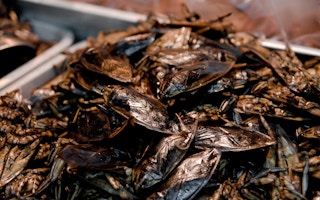Insects have great potential as an alternative source of protein, but further research is urgently needed before mass production begins in order to avoid environment disaster, Swedish researchers warned Monday.
There is currently an “overwhelming lack of knowledge” on basic questions such as suitable species, their housing and feed requirements, managing their waste and that escaping insects do not wreak havoc on the ecosystem, they said.
Unless such issues are studied and discussed in a critical manner, “we risk creating an industry that replaces one environmental problem with another,” they wrote in the journal Trends in Ecology & Evolution.
Globally, growing demand for animal protein has led to expanded cultivation of soybeans to feed livestock and poultry, but critics say the system is unsustainable and leads to deforestation and overuse of farm chemicals.
Nutritionists and scientists have been touting insects as sustainable and cheap source of protein to feed a growing world because they are high in protein, vitamins, fibre and minerals.
Insects emit fewer greenhouse gases and less ammonia than cattle or pigs and require significantly less land and water than cattle, according to the United Nations’ Food and Agriculture Organization (FAO).
“
One of the biggest threats to both natural systems and production systems the world over is invasive species. What happens if insects are accidentally released in a country to which they are imported?
Asa Berggren, conservation biologist, Swedish University of Agricultural Sciences
More than 1,900 species of insects are edible, according to the FAO.
Businesses are already jumping into the sector, producing burgers made of buffalo worms, sweet potato soup made with bugs, grubs as pet food and DIY insect farms.
However, “future environmental impact of the mass rearing of insects is largely unknown,” said the Swedish scientists.
“How do you produce the feed they eat, where do you produce it, what do you use? There are so many questions,” said Asa Berggren, a conservation biologist at the Swedish University of Agricultural Sciences and the paper’s co-author.
“Are we going to use fossil fuels for heating and cooling the facilities (where insects are grown)? What about transportation?” she said to the Thomson Reuters Foundation via phone.
“One of the biggest threats to both natural systems and production systems the world over is invasive species. What happens if insects are accidentally released in a country to which they are imported? Insects are tiny and they get out,” Berggren said.
“We don’t believe it’s good enough to just switch from some species to another,” she said.
Other outstanding questions include whether reared insects who fall sick risk transmitting diseases to consumers, how their wastes are disposed of and how animal welfare should be measured in insects, the researchers said.
Further research is also important, Berggren said, because “there could be a lot of insects that could be very good for us to eat but no one knows because no one has looked at that.”
This story was published with permission from Thomson Reuters Foundation, the charitable arm of Thomson Reuters, that covers humanitarian news, climate change, resilience, women’s rights, trafficking and property rights. Visit http://news.trust.org/climate.










